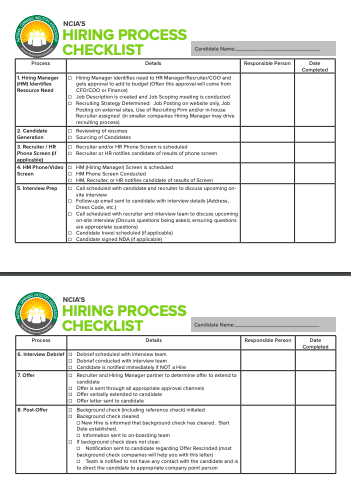by NCIA’s Human Resource Committee:
Kara Bradford of Viridian Staffing, Kerry Arnold of Canndescent, Heidi Quan of Murchison & Cumming LLP, Nichole McIntyre of Urban-Gro, Michelle Whitmore of H2 Talent, and Mark Hackett of Emerge Law Group.
Maybe you’re just getting your business started. Perhaps you’ve already been rolling full steam ahead. Either way, people are crucial to your business. The NCIA Human Resource Committee formed this past year. The committee, headed by Kara Bradford of Viridian Staffing, includes experienced HR Practitioners, Recruiters and Employment Attorneys, who have all brought their collective “best practices” together in an effort to assist NCIA members to navigate the often complex world of employment.
The HR Committee is starting off by releasing a series of checklists to provide some essential guidelines for your firm during the hiring, on-boarding and termination phases of employment. Without further ado…
Welcome to the first installment of the NCIA Human Resources Committee Employer Checklist Series! Today, we begin where every employer begins – the hiring process – and present the Hiring Process Checklist. Although laws may vary from state to state and each employer’s approach to hiring may differ, the Hiring Process Checklist provides a framework to assure your hiring process includes basic best practices, so you can attract and hire the best candidates.
Why is it important to have a well thought out hiring process? In this era of full employment, you just need to hire warm bodies before your competitors, right? Wrong! There are at least three critical reasons to make sure you put a good hiring process in place.
First, your hiring process must comply with the law. Are your job postings nondiscriminatory? Does your job application request potentially illegal information, such as criminal background, salary history or prior workers’ compensation claims? Are interviewers only asking applicants appropriate questions? Are you storing applications and other information about applicants for the required length of time? A good hiring process greatly reduces your risk of legal problems.
Second, hiring the wrong applicant is expensive. According to a study by SHRM (The Society for Human Resource Management), the average cost of hiring an employee is just over $4,100. This does not include the cost of training a new employee, a new employee’s lower productivity and greater likelihood of making mistakes or the stress on your other employees who must pick up the slack while the new employee ramps up. A good hiring process can improve your bottom line by significantly increasing the likelihood that you hire the right employee the first time.
The third and perhaps most important reason to lock down your hiring process: you are introducing potential employees to your company for the very first time. From the time they read your job posting until you inform them of your hiring decision, the applicant is assessing and judging your company. In this competitive job market, you need to quickly give that applicant a reason to want to work for you, rather than all the other hungry employers vying for their services.
 An unstructured, haphazard hiring process sends all the wrong messages. Right or wrong, it tells an applicant that the company is not serious about hiring the best employees. It tells the applicant that you don’t value their time. Would you want to work at that company?
An unstructured, haphazard hiring process sends all the wrong messages. Right or wrong, it tells an applicant that the company is not serious about hiring the best employees. It tells the applicant that you don’t value their time. Would you want to work at that company?
You only get to make one first impression, so make it a good one! Be upfront and clear with the applicant about the hiring process and your timeline and stick to them. Keep the interview process on schedule and make sure interviewers are well-prepared. If you tell an applicant you will get back to them by a certain date, get back to them by that date. If the timeline changes, let the applicant know. Treat every applicant with respect at every stage of the hiring process.
Once you establish your hiring process, the hard part begins – putting the plan into action. Even the best hiring process is useless if your staff doesn’t understand it. Clearly explain the hiring process to staff who will implement or supervise it. Provide them with the training and tools they need. Finally, periodically review the success of the hiring process and make improvements, so you continue to attract high-quality job applicants.
We hope you find the Hiring Process Checklist a useful tool as you develop your company’s hiring process, but it is not the only tool available. Take advantage of the many resources available to you in books and magazines, on the internet, and through the services of an HR professional or attorney.
Happy hiring!
The HR Committee needs and values your feedback. We exist to serve NCIA members, so please tell us how we can serve your needs by emailing us at HRC@TheCannabisIndustry.org. Thank you.


Follow NCIA
Newsletter
Facebook
Twitter
LinkedIn
Instagram
–